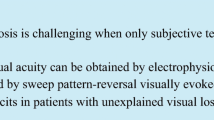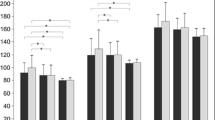Abstract
Background
The aim of the study was to validate the use of the short duration pattern onset visual evoked potential (PappVEP) in the objective assessment of visual acuity (VA) in patients referred with presumed non-organic visual loss.
Methods
The combination of minimum check size and minimum contrast required to elicit a consistently discernible PappVEP (amplitude ≥5 μV) were measured in ten normal subjects under conditions of induced optical blur (0 to +3 dioptres) and the relationship to Snellen VA established. The data from 100 consecutive patients (167 eyes) referred for possible non-organic visual loss (NOVL) and 20 patients with confirmed visual pathway dysfunction were reviewed in relation to the results in normal subjects.
Results
Snellen VA, under conditions of blur, could be predicted in normal subjects from the check size and contrast required to elicit a criterion PappVEP. These data were tabulated and a quantitative guideline established for the estimation of VA in the patients referred with suspected NOVL. Most (88%) patients referred with suspected NOVL had normal electrophysiology and PappVEPs consistent with normal Snellen VA. In others, they suggested a degree of non-organic overlay. In 20 cases of organic visual loss, PappVEPs were in close agreement with subjective VA.
Conclusions
The short duration pattern onset visual-evoked potential is confirmed as a clinically useful tool in the objective assessment of patients with suspected non-organic visual loss.






Similar content being viewed by others
References
Arai M, Katsumi O, Paranhos FRL, Lopes De Faria JM, Hirose T (1997) Comparison of Snellen acuity and objective assessment using the spatial frequency sweep PVER. Graefe’s Arch Clin Ophthalmol 235:442–447
Arden GB, Lewis DRH (1973) The pattern visual evoked response in the assessment of visual acuity. Clarke WN, Noël L-P. Trans Ophthalmol Soc UK 93:39–48
Bach M, Hawlina M, Holder GE, Marmor MF, Meigan T, Vaegan, Miyake Y (2000) Standard for pattern electroretinography. Doc Ophthalmol 101:11–18
Bain KE, Beatty S, Lloyd C (2000) Non-organic visual loss. Eye 14:770–772
Beatty S (1999) Non-organic visual loss. Postgrad Med J 75:201–207
Barris MC, Kaufman DI, Barberio D (1992) Visual impairment in hysteria. Invest Ophthalmol Vis Sci 33:1227–1232
Bobak P, Khanna P, Goodwin J, Brigell M (1993) Pattern visual evoked potentials in cases of ambiguous acuity loss. Doc Ophthamol 85:185–192
Campbell FW, Maffei L (1970) Electrophysiological evidence for the existence of orientation and size detectors in the human visual system. 207:635–652
Catalano RA, Simon JW, Krohel GB, Rosenberg PN (1986) Functional visual loss in children. Ophthalmology 93:385–390
Celesia GG, Archer CR, Kuroiwa Y et al (1980) Visual function of the extrageniculo-calcarine system in man. Arch Neurol 37:704–706
Chiappa KH (1990) Evoked potentials in clinical medicine, 2nd edn. Raven Press, New York
Clarke WN, Noël L-P, Bariciak M (1996) Functional visual loss in children: a common problem with an easy solution. Can J Ophthamol 31:311–313
Fishman GA, Birch DG, Holder GE, Brigell MG (2001) Electrophysiologic testing in disorders of the retina, optic nerve and visual pathway 2nd ed. San Francisco, CA: The Foundation of the American Academy of Ophthalmology
Holder GE (2006) Electrodiagnostic testing in malingering and hysteria. In: Heckenlively JR, Arden GB (eds) Principles and practice of clinical electrophysiology of vision. 1st ed. St. Louis: Mosby Year Book 573–577
Howe JW, Mitchell KW, Robson C (1981) Electrophysiological assessment of visual acuity. Trans Ophthalmol Soc UK 101:105–108
Howe JW, Mitchell KW, Robson C (1982) Some clinical experiences using contrast evoked potential techniques in organic and non-organic visual dysfunction. Doc Ophthalmol Proc Ser 31:353–360
Howe JW, Mitchell KW (1984) The objective assessment of contrast sensitivity by electrophysiological means. Br J Ophthalmol 68:626–638
Jenkins TCA, Douthwaite WA (1988) An objective VER assessment of visual acuity compared with subjective measures. Am J Optom Physiol Optics 65:957–961
Jetzel J, Parry N (2001) Minimising the effects of spatial non-linearities on VEP estimation of resolution limit. IOVS 42:5854 (ARVO abstract 4584-B603)
Kathol RG, Cox TA, Corbett JJ, Thompson HS (1983) Functional visual loss: follow-up of 42 cases. Arch Ophthalmol 101:729–735
Kramer KK, Piana FG, Appleton B (1979) Ocular malingering and hysteria: diagnosis and management. Surv Ophthalmol 24:89–96
Kulikowski JJ (1972) Relation of psychophysics and electrophysiology. Trace (Paris) 6:64–69
Marmor MF, Holder GE, Seeliger MW, Yamamoto S (2004) Standard for clinical electroretinography (2004 update). Doc Ophthalmol 108:107–114
Morgan RK, Nugent B, Harrison JM, O’Connor PS (1985) Voluntary alteration of pattern evoked responses. Ophthalmology 92:1356–1363
Muller W, Schoeneich H (1989) Relationship between visual acuity, refraction, and the pattern reversal evoked potential in aphakia. Ophthalmologica 198:89–94
Murray IJ and Kulikowski JJ (1983) VEPs and contrast. 23:1741–1743
Odom JV, Bach M, Barber C, Brigell M, Marmor MF, Tormene AP, Holder GE, Vaegan (2004) Visual Evoked Potentials Standard. Doc Ophthalmol 108:115–123
Ohn Y-H, Katsumi O, Matsui Y, Tetsuka H, Hirose T (1994) Snellen visual acuity versus pattern reversal visual-evoked response acuity in clinical applications. Ophthalmic Res 26:240–252
Parry NRA, Murray IJ, Hadjzenonous C (1999) Spatio-temporal tuning of VEPs: effect of mode of stimulation. Vision Res 39:3491–3497
Raniel Y, Pratt H, Neumann E, Schacham SE (1989) Miniature fiber-optic pattern-reversal stimulator for determination of the visual evoked potential threshold; comparison with Snellen acuity. Graefe’s Arch Ophthalmol 227:212–215
Regan D (1989) Human brain electrophysiology: evoked potentials and evoked magnetic fields in science and medicine, 1st edn. Elsevier, New York
Robson AG, Kulikowski JJ, Korostenskaja M, Neveu MM, Hogg CH, Holder GE (2003) Integration times reveal mechanisms responding to isoluminant chromatic gratings: a two centre visual evoked potential study. In: Mollon JD, Pokorny J, Knoblauch K (eds) Normal and defective colour vision. 1st ed. Oxford university press, New York, pp 130–137
Rover J, Bach M (1987) Pattern electroretinogram plus visual evoked potential: a decisive test in patients suspected of malingering. Doc Ophthalmol 66:245–251
Skalka HW (1980) Comparison of Snellen acuity, VER acuity and Arden grating scores in macular and optic nerve diseases. Br J Ophthalmol 64:24–29
Sokol S, Dobson V (1976) Pattern reversed visually evoked potentials in infants. Investig Ophthalmol 15:58–63
Sokol S, Jones K, Nadler D (1983) Comparison of the spatial response properties of the human retina and cortex as measured by simultaneously recorded patter ERGs and VEPs. Vision Res 23:723–727
Spekreijise H, Van der Tweel LH, Zuidema TH (1973) Contrast evoked responses in man. Vision Res 13:1577–1601
Steele M, Seiple WH, Carr RE, Klug R (1989) The clinical utility of visual-evoked potential acuity testing. Am J Ophthalmol 108:572–577
Tan CT, Murray NMF, Sawyers D, Leonard TJK (1984) Deliberate alteration of the visual evoked potential. J Neurol Neurosurg Psychiat 47:518–523
Van Lithe G, Van Marle W, Bartl G, Vijfwinkel-Bruininga S (1976) Visual acuity and checkerboard potentials with defocusing lenses. Doc Ophthalmol Proc Ser 13:13–19
Xu S, Meyer D, Yoser S, Mathews D, Elfervig JL (2001) Pattern visual evoked potential in the diagnosis of functional visual loss. Ophthalmology 108:76–81
Brecelj J (2003) From immature to mature pattern ERG and VEP. Doc Ophthalmol 107:215–224
Emmerson-Hannover R, Shearer DE, Creel DJ, Dustman RE (1994) Pattern reversal evoked potentials: gender differences and age-related changes in amplitude and latency. Electroencephalogr Clin Neurophysiol 92:93–101
Acknowledgements
The authors would like to thank the technicians in the electrophysiology department for performing the clinical testing on many of the patients and Catey Bunce for her statistical advice.
Author information
Authors and Affiliations
Corresponding author
Rights and permissions
About this article
Cite this article
McBain, V.A., Robson, A.G., Hogg, C.R. et al. Assessment of patients with suspected non-organic visual loss using pattern appearance visual evoked potentials. Graefe's Arch Clin Exp Ophthalmol 245, 502–510 (2007). https://doi.org/10.1007/s00417-006-0431-2
Received:
Revised:
Accepted:
Published:
Issue Date:
DOI: https://doi.org/10.1007/s00417-006-0431-2




